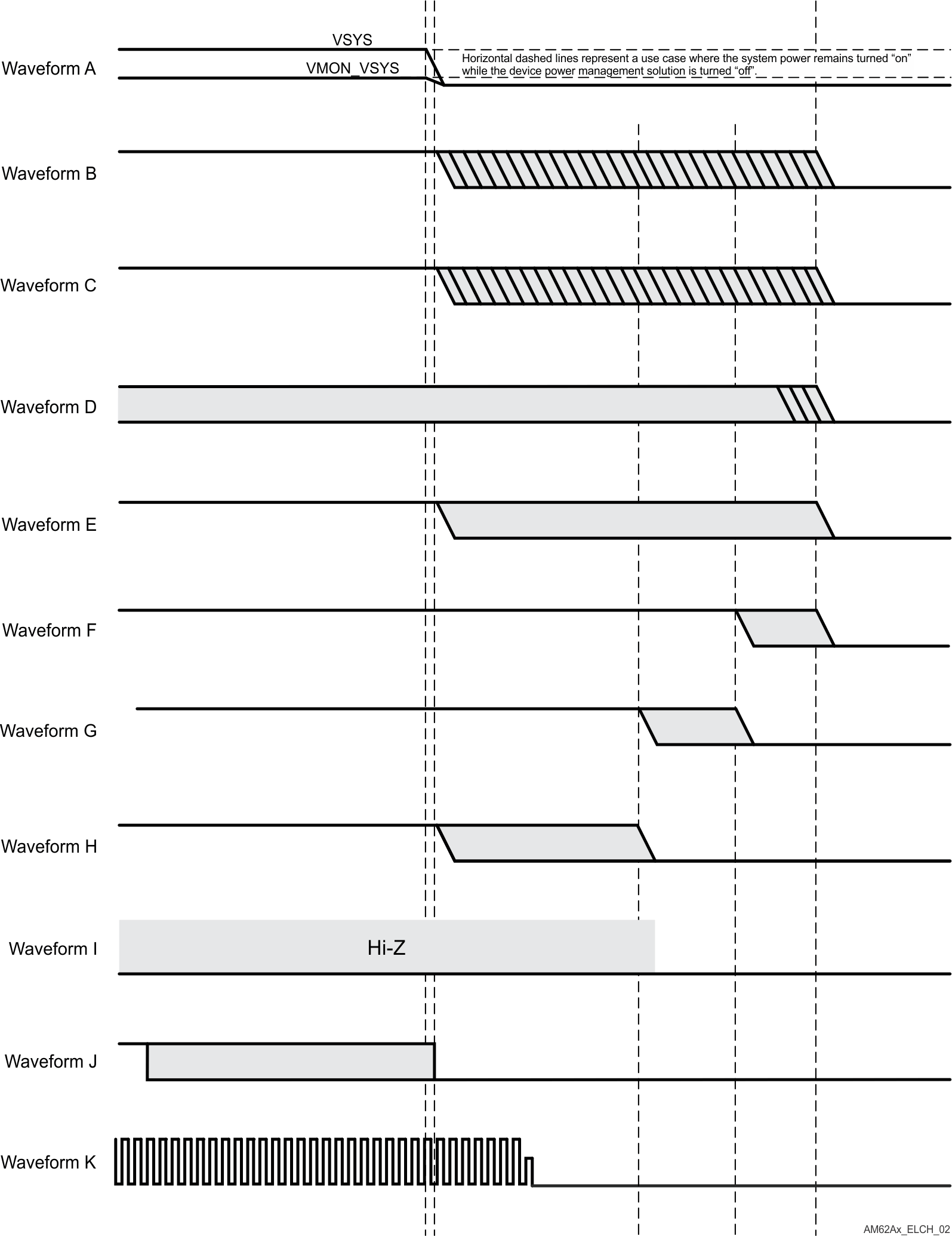SPRSP96A March 2024 – September 2024 TDA4AEN-Q1 , TDA4VEN-Q1
PRODUCTION DATA
- 1
- 1 Features
- 2 Applications
- 3 Description
- 4 Device Comparison
-
5 Terminal Configuration and Functions
- 5.1 Pin Diagrams
- 5.2 Pin Attributes
- 5.3
Signal Descriptions
- 13
- 5.3.1 CPSW3G
- 5.3.2 CPTS
- 5.3.3 CSI-2
- 5.3.4 DDRSS
- 5.3.5 DSI
- 5.3.6 DSS
- 5.3.7 ECAP
- 5.3.8 Emulation and Debug
- 5.3.9 EPWM
- 5.3.10 EQEP
- 5.3.11 GPIO
- 5.3.12 GPMC
- 5.3.13 I2C
- 5.3.14 MCAN
- 5.3.15 MCASP
- 5.3.16 MCSPI
- 5.3.17 MDIO
- 5.3.18 MMC
- 5.3.19 OLDI
- 5.3.20 OSPI
- 5.3.21 Power Supply
- 5.3.22 Reserved
- 5.3.23 SERDES
- 5.3.24 System and Miscellaneous
- 5.3.25 TIMER
- 5.3.26 UART
- 5.3.27 USB
- 5.4 Pin Connectivity Requirements
-
6 Specifications
- 6.1 Absolute Maximum Ratings
- 6.2 ESD Ratings for AEC - Q100 Qualified Devices in the AMW Package
- 6.3 Power-On Hours (POH)
- 6.4 Recommended Operating Conditions
- 6.5 Operating Performance Points
- 6.6
Electrical
Characteristics
- 6.6.1 I2C Open-Drain, and Fail-Safe (I2C OD FS) Electrical Characteristics
- 6.6.2 Fail-Safe Reset (FS RESET) Electrical Characteristics
- 6.6.3 High-Frequency Oscillator (HFOSC) Electrical Characteristics
- 6.6.4 Low-Frequency Oscillator (LFXOSC) Electrical Characteristics
- 6.6.5 SDIO Electrical Characteristics
- 6.6.6 LVCMOS Electrical Characteristics
- 6.6.7 CSI-2 (D-PHY) Electrical Characteristics
- 6.6.8 USB2PHY Electrical Characteristics
- 6.6.9 DDR Electrical Characteristics
- 6.7 VPP Specifications for One-Time Programmable (OTP) eFuses
- 6.8 Thermal Resistance Characteristics
- 6.9
Timing and Switching Characteristics
- 6.9.1 Timing Parameters and Information
- 6.9.2 Power Supply Requirements
- 6.9.3 System Timing
- 6.9.4 Clock Specifications
- 6.9.5
Peripherals
- 6.9.5.1 ATL
- 6.9.5.2 CPSW3G
- 6.9.5.3 CPTS
- 6.9.5.4 CSI-2
- 6.9.5.5 CSI-2 TX
- 6.9.5.6 DDRSS
- 6.9.5.7 DSS
- 6.9.5.8 ECAP
- 6.9.5.9 Emulation and Debug
- 6.9.5.10 EPWM
- 6.9.5.11 EQEP
- 6.9.5.12 GPIO
- 6.9.5.13 GPMC
- 6.9.5.14 I2C
- 6.9.5.15 MCAN
- 6.9.5.16 MCASP
- 6.9.5.17 MCSPI
- 6.9.5.18 MMCSD
- 6.9.5.19 OSPI
- 6.9.5.20 PCIe
- 6.9.5.21 Timers
- 6.9.5.22 UART
- 6.9.5.23 USB
- 7 Detailed Description
-
8 Applications,
Implementation, and Layout
- 8.1 Device Connection and Layout Fundamentals
- 8.2 Peripheral- and Interface-Specific Design Information
- 8.3 Clock Routing Guidelines
- 9 Device and Documentation Support
- 10Revision History
- 11Mechanical, Packaging, and Orderable Information
6.9.2.2.2 Power-Down Sequencing
Table 6-5 and Figure 6-6 describes the device power-down sequencing.
Note: The power supply sequencing
requirements defined in this section does not include entry or exit from low power
modes. See the
Partial IO Power
Sequencing section for more information on the requirements for
entering or exiting from Partial IO low power mode.
Note: All power rails must be turned off
and decay below 300mV before initiating a new power-up sequence anytime a power rail
drops below the minimum value defined in Recommended Operating Conditions.
The only exception is when entering/exiting Partial IO low power mode with
VDDSHV_CANUART and VDD_CANUART sourced from an always on power source. For this use
case the VDDSHV_CANUART and VDD_CANUART power rails are allowed to remain on.
Table 6-5 Power-Down Sequencing – Supply
/ Signal Assignments See: Figure 6-6
| WAVEFORM | SUPPLY / SIGNAL NAME |
|---|---|
| A | VSYS, VMON_VSYS |
| B | VDDSHV_CANUART(1), VDDSHV_MCU(1), VDDSHV0(1), VDDSHV1(1), VDDSHV2(1), VDDSHV3(1), VDDA_3P3_USB, VMON_3P3_SOC |
| C | VDDSHV_CANUART(2), VDDSHV_MCU(2), VDDSHV0(2), VDDSHV1(2), VDDSHV2(2), VDDSHV3(2), VDDS_MMC0, VDDA_MCU, VDDS_OSC0, VDDA_PLL0, VDDA_PLL1, VDDA_PLL2, VDDA_1P8_CSI_DSI, VDDA_1P8_OLDI0, VDDA_1P8_USB, VDDA_TEMP0, VDDA_TEMP1, VMON_1P8_SOC |
| D | VDDSHV5(3), VDDSHV6(3) |
| E | VDDS_DDR, VDDS_DDR_C |
| F | VDD_CANUART(4) |
| G | VDD_CANUART(5), VDD_CORE(5), VDDA_CORE_CSI_DSI(5), , VDDA_CORE_DSI_CLK(5), VDDA_CORE_USB0(5), VDDA_DDR_PLL0(5) |
| H | VDD_CANUART(6), VDD_CORE(6), VDDA_CORE_CSI_DSI(6), , VDDA_CORE_DSI_CLK(6), VDDA_CORE_USB0(6), VDDA_DDR_PLL0(6), VDDR_CORE, VDD_MMC0, VDDA_0P85_DLL_MMC0 |
| I | VPP |
| J | MCU_PORz |
| K | MCU_OSC0_XI, MCU_OSC0_XO |
(1) VDDSHV_CANUART, VDDSHV_MCU, and
VDDSHVx [x=0-3] when operating at 3.3V.
(2) VDDSHV_CANUART, VDDSHV_MCU, and
VDDSHVx [x=0-3] when operating at 1.8V.
(3) VDDSHV5, and VDDSHV6 were
designed to support power-up, power-down, or dynamic voltage change without any
dependency on other power rails. This capability is required to support UHS-I SD
Cards.
(4) VDD_CANUART when connected to an
always-on power source for Partial IO low power mode.
(5) VDD_CANUART, VDD_CORE,
VDDA_CORE_CSI_DSI, VDDA_CORE_DSI_CLK, VDDA_CORE_USB0, and VDDA_DDR_PLL0 when
operating at 0.75V
(6) VDD_CANUART, VDD_CORE,
VDDA_CORE_CSI_DSI, VDDA_CORE_DSI_CLK, VDDA_CORE_USB0, and VDDA_DDR_PLL0 when
operating at 0.85V
 Figure 6-6 Power-Down Sequencing
Figure 6-6 Power-Down Sequencing